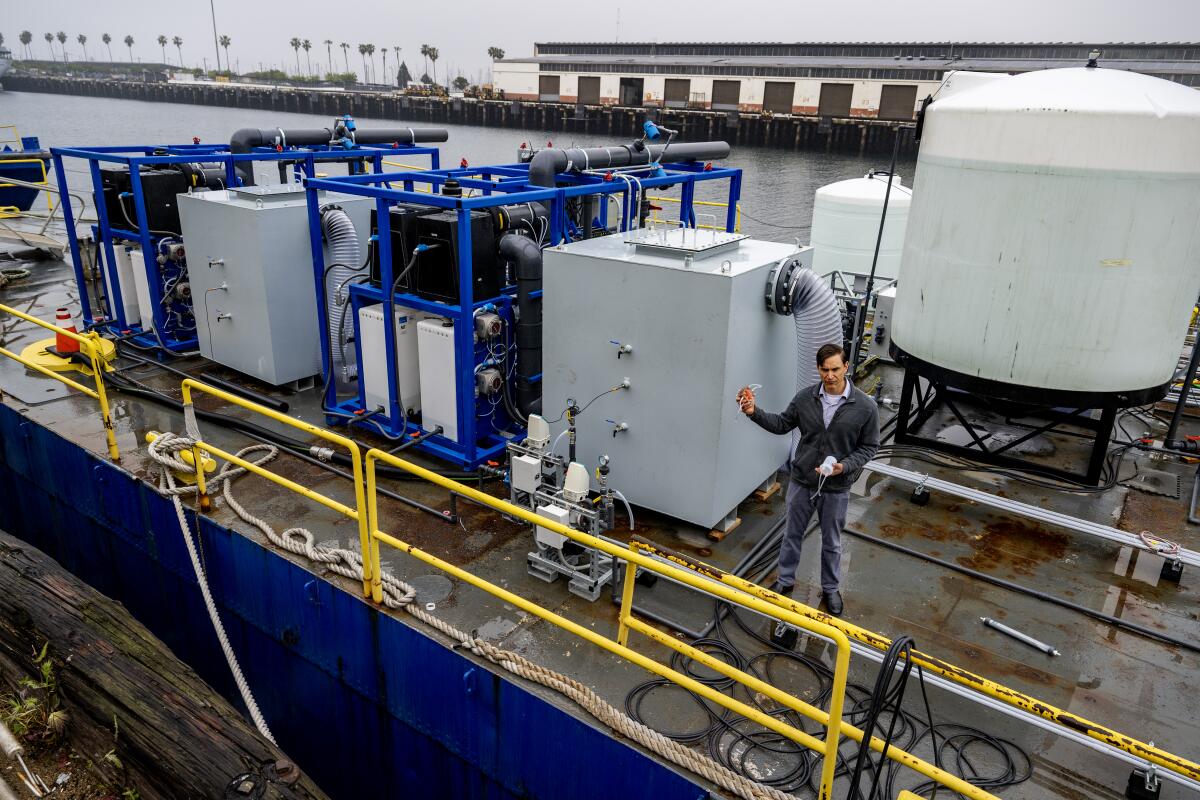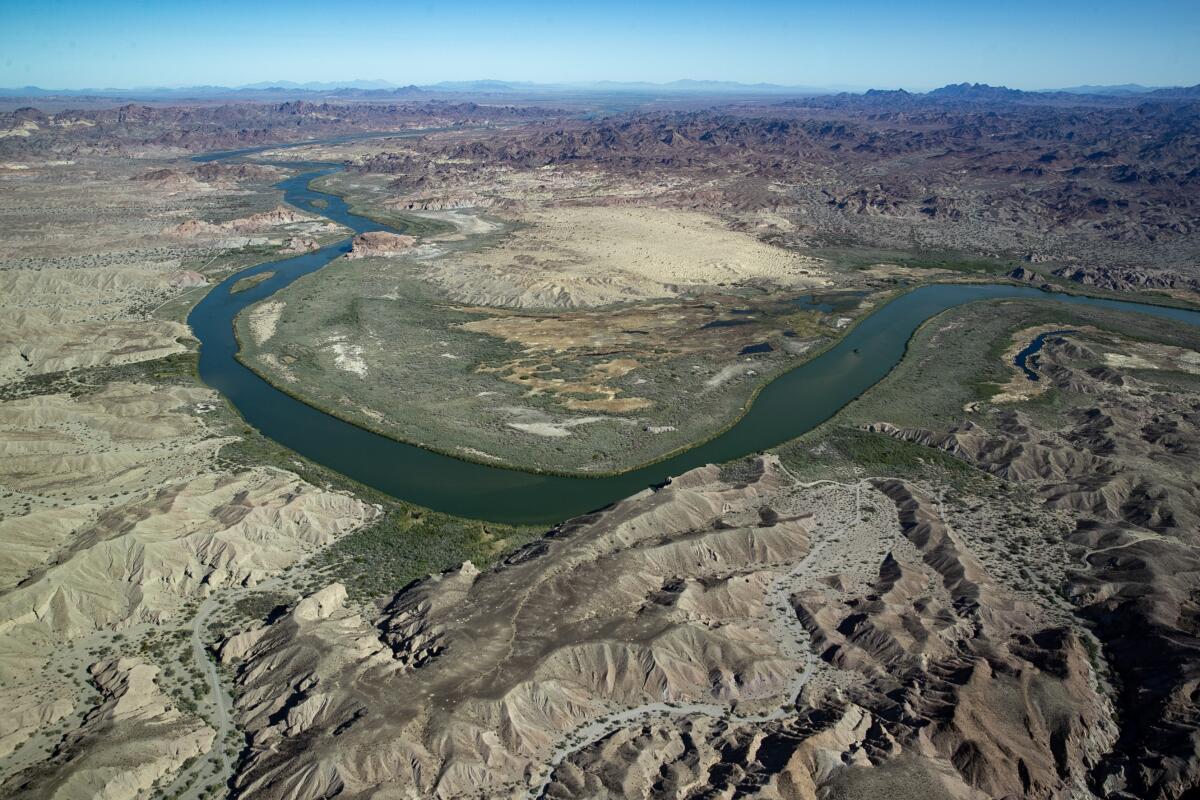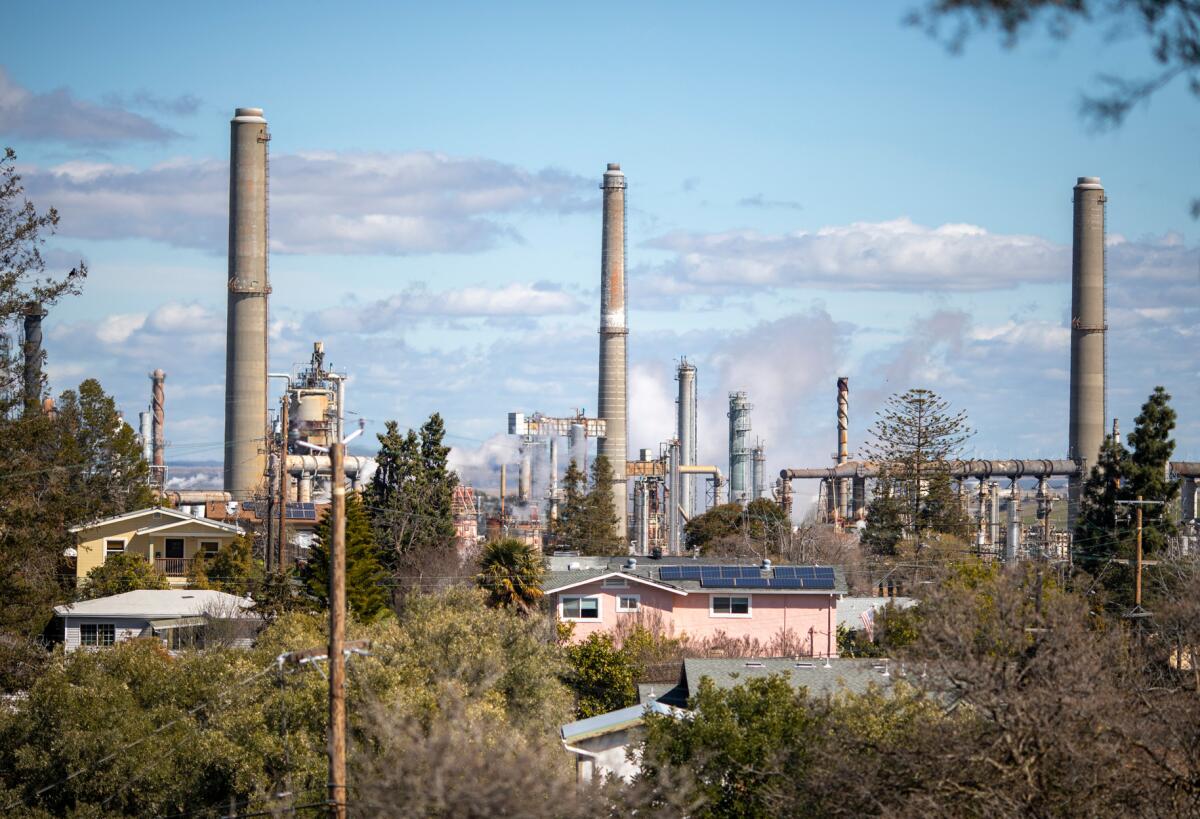Could removing carbon from the ocean be a climate change solution?

- Share via
This is the April 13, 2023, edition of Boiling Point, a weekly newsletter about the environment across California and the American West. Sign up here to get it in your inbox.
Hello there! It’s Rosanna Xia, coastal reporter for the Los Angeles Times, filling in for Sammy Roth.
When an email from UCLA landed in my inbox, inviting me to check out an ocean-based carbon-removal system that its engineering faculty had just developed, I was (to say the least) very intrigued.
The ocean, after all, has long been a silent hero when it comes to climate change. It has absorbed almost one-third of the carbon dioxide released by humans since the Industrial Revolution — and more than 90% of the resulting heat. Talk long enough to anyone who works in marine science, and you’ll inevitably hear someone sigh and explain that this issue often flies so under the radar that it’s now dubbed “the other CO2 problem.”
This excess heat from unchecked carbon emissions has unfolded in insidious ways underwater. Sea level rise. More intense marine heat waves. And when carbon dioxide mixes with seawater, it undergoes chemical reactions that increase the water’s acidity, which can discombobulate fish and wreak havoc on marine ecosystems. Our coral reefs are dying, and scientists have also found that harmful algal blooms are getting more toxic — and occurring more frequently.
In the year 2021 alone, the world’s oceans got hotter by about 14 zettajoules. This is a mind-bending number, so thermal scientist John Abraham, at the University of St. Thomas in Minnesota, put it this way in an op-ed in the Guardian: “The oceans have absorbed heat equivalent to seven Hiroshima atomic bombs detonating each second, twenty-four hours a day, three hundred sixty-five days a year.”
So with all that in mind, I took a tour Wednesday of what has been billed as a game-changing, first-of-its-kind technology in removing carbon dioxide from the ocean. The pilot system, dubbed SeaChange, essentially pumps in seawater, extracts the carbon dioxide, and then, through a surprisingly simple process, converts the CO2 into a solid mineral that can be stored safely away. This in turn frees up the ocean to absorb more carbon emissions from the atmosphere. It’s a multimillion-dollar idea that researchers from the UCLA Samueli School of Engineering have been putting to the test.
It was a drizzly, gray morning as we gathered along the docks of the new AltaSea campus at the Port of Los Angeles, but spirits were high. Gaurav Sant, the director of UCLA’s Institute for Carbon Management, beamed with excitement as he talked about all the pieces to the electrochemical reactor and explained the intricate rebalancing systems that his team had designed and built atop a 100-foot-long barge.
To start the carbon-removal process, the researchers first run an electrical charge through the water. (Seawater, I learned that day, holds about 150 times more carbon dioxide than air per unit of volume). The electrolysis makes the water alkaline, which initiates a series of chemical reactions that ultimately neutralizes and traps the carbon dioxide into calcium carbonate — a fine powdery mineral that is found in seashells and limestone.
“The process relies on really simple, really elegant chemistry,” Sant said, adding that he was particularly proud of how remarkably energy efficient his team was able to make this whole operation. In a unique twist, hydrogen also gets created as a co-product, which helps power the carbon-removal equipment. (For every 220 metric tons of seawater that gets processed, about one metric ton of CO2 gets removed, while simultaneously producing about 35 kilograms of hydrogen.)

And get this, it’s not only the carbon-free seawater that gets released back into the ocean. The calcium carbonate also gets returned to the seafloor. It seems counterintuitive to put this hardened carbon back into the ocean, but Sant explained that this is a natural mineral that belongs to the inherent balance of the ocean. And considering that the ocean covers more than 70% of the surface of the planet, this method of storage is arguably more scalable than if we tried to store carbon underground.
The journey ahead is long, and how to scale this operation is still being worked out, but Sant said we owe it to ourselves to try. To really make a difference in climate change, we would need to remove at least 10 billion to 20 billion metric tons of carbon dioxide per year. This would require at least 1,800 industrial-scale versions of what Sant’s team has developed, costing many, many more millions of dollars.
As I held up a jar filled with this cloudy limestone slurry, it was humbling to think of all this carbon dioxide hardened into powered rock — carbon dioxide that has caused so much uncertainty over just how livable our planet will be in the future. At a time when climate anxiety and even grief have pushed its way into our collective consciousness, it was striking to see so much excitement (and dare I say, hope?) from engineers who really feel as though they’ve cracked one piece of the code to this global crisis.
“The oceans are the world’s largest sink of carbon dioxide emissions,” Sant said. “The ability to couple an engineering intervention with such an incredibly large natural system is one of the only ways we’re going to be able to tackle a problem this large, in terms of size and scale.”
On that note, here’s what else is happening around the West:
STILL NOT ENOUGH WATER

The moment of reckoning on the Colorado River draws closer. The U.S. Bureau of Reclamation laid out two options this week for preventing the river’s depleted reservoirs from falling to critically low levels: Officials could either impose water cuts across the Southwest by following the water-rights priority system — or by using an across-the-board percentage. My colleague Ian James has the latest on these proposed reductions, and as he noted last week on his aerial tour of the infrastructure at play, even though the Colorado River has gotten some relief from this winter’s snow, a long-term water crisis remains.
As for California’s remarkably wet winter, the state now has so much snow that flood danger will actually last for months, Hayley Smith reports in The Times. The record-deep snowpack in the southern Sierra Nevada is expected to send a cascade of water down into the San Joaquin Valley as it melts, and officials are warning residents who live in the potential path of runoff to remain alert. The ski community up in Mammoth Lakes, meanwhile, still finds itself overwhelmed by snow measuring up to 30 feet deep. Shovel crews have been working around the clock to dig out businesses and homeowners, according to this dispatch by Louis Sahagún.
In other water news, a Bloomberg investigation found that banks, pension funds and insurers have been turning California’s groundwater into enormous profits, leaving people with less to drink. In a note on Twitter, Mark Chediak described how he and his colleagues Peter Waldman and Sinduja Rangarajan “spent months digging through public records, deeds and state filings to illustrate the extent at which some of the world’s largest institutional investors have been depleting California’s groundwater to grow high-value almonds, pistachios and grapes.”
TOXIC POLLUTION

When a Bay Area oil refinery accidentally released as much as 24 tons of metal-laden dust in Martinez last year, the pollution showered onto a nearby junior high school and may have traveled up to a dozen miles into neighboring areas. But residents weren’t notified until months later, and they’re just now learning the extent of the potential fallout. My colleague Tony Briscoe breaks down the latest revelations finally coming to light for the community.
This piece in Orion Magazine doesn’t quite take place out West, but Rebecca Altman’s latest research into the history of polyvinyl chloride, or PVC, told through the toxic train derailment in East Palestine, Ohio, is a universal lesson in the harmful consequences of plastic production.
Speaking of plastic ... new research has found that rainbow trout are more likely to die from a common disease, known as infectious hematopoietic necrosis virus, when exposed to high concentrations of nylon microfibers and other microplastics. Elise Cutts dives into this latest study for Hakai Magazine.
On a less gloomy note, the Biden administration is rolling out more than $690 million to help California clean up lead, forever chemicals like PFAS, and other contaminants in drinking water, the Sacramento Bee reports. The funding will also help patch up dilapidated water delivery infrastructure.
NATIONAL PARKS AND FORESTS
Turkiya Lowe, the first Black person and the first woman to serve as principal historian of the National Park Service, has the unique responsibility of reshaping how our national parks tell the story of America. In this interview with Jessica Kutz in the 19th, Lowe talks about her inspiration in becoming a historian — and how she is now focusing on everyday people and unsung heroes.
The U.S. Forest Service has decided to move forward with its plan to clear-cut mature pines on the border of Yellowstone National Park, despite new guidance issued by the Biden administration to provide a detailed accounting of the cost in carbon emissions. The logging project in Custer Gallatin National Forest in Montana shows the limitations of this new greenhouse gas policy, Marianne Lavelle reports for Inside Climate News.
Meanwhile, in Arizona, tribal leaders and elected officials are calling on President Biden to designate 1.1 million acres adjacent to Grand Canyon National Park as the Baaj Nwaavjo I’tah Kukveni Grand Canyon National Monument, Jake Frederico reports in the Arizona Republic.
On another note, a 14,000-year-old grove of aspens in Utah, famously known as Pando, is dying after a hundred years of human meddling. In a sobering reflection on this reality, Bloomberg opinion columnist Faye Flam writes that “changes in climate, and changes in the populations of plants and animals, are happening so fast that we could lose some of our most interesting life forms before we’ve even had time to understand them.”
OBSCURE ANIMALS
Most of us are familiar with what ecologists call “charismatic megafauna” (dolphins, pandas and mountain lions like P-22, just to name a few). But less charismatic species are in peril, too. The Recovering America’s Wildlife Act, a bipartisan bill that was recently reintroduced, seeks to save snot otters, heelsplitters, mudbugs and many other critters from the brink of extinction. Maxine Joselow and Dino Grandoni at the Washington Post break down the details.

This week, I learned about the Velella velella, a jellyfish-like creature with tiny blue tentacles. They’re technically hydroids (a type of invertebrate), and thousands of them have been washing ashore in both Northern and Southern California. Also known as “by-the-wind sailors,” these fascinating critters usually go unnoticed during the spring and summer, but scientists told my colleague Salvador Hernandez that every few years, food conditions can drive their numbers up and winds will push them toward the coast.
In other obscure critter news, a sunflower sea star was spotted off the Mendocino coast. The declining species has struggled to survive amid rapidly warming water and pollution, as Kate Fishman explains in the Mendocino Voice. And my colleague Jack Dolan wrote how an abundance of microscopic, particle-eating zooplankton has helped make Lake Tahoe clearer than it has been in decades.
And I’m a few weeks behind, but consider this your reminder to read Elizabeth Kolbert’s fascinating piece in the New Yorker on the little-known (and underappreciated) world of caterpillars.
ONE MORE THING
If you happen to be in Los Angeles next weekend and want to geek out with me about writing, I will be moderating the climate nonfiction panel at the Los Angeles Times Festival of Books. The two-day gathering, held every year at USC, is the nation’s largest literary event, and it has been inspiring to see the growing number of environmental writers taking a seat on stage.
The climate nonfiction panel is at 1:30 p.m. Saturday, April 22, and it will feature the following authors: Juli Berwald (“Life on the Rocks: Building a Future for Coral Reefs”); Jessica Hernandez (“Fresh Banana Leaves: Healing Indigenous Landscapes Through Indigenous Science”); John Perlin (“A Forest Journey: The Role of Trees in the Fate of Civilization”); and Leila Philip (“Beaverland: How One Weird Rodent Made America”). Send me your questions, I’d love to hear your thoughts!
And I can’t sign off without sharing a few other environmental-themed books currently on my nightstand: I’ve been studying the prose in John Messick’s “Compass Lines: Journeys Toward Home,” a wondrous collection of essays published by Porphyry Press, a cool indie publisher based in Alaska’s Wrangell Mountains; and I just picked up Jake Bittle’s “The Great Displacement: Climate Change and the Next American Migration,” which Jeff Masters recently reviewed in Yale Climate Connections.
“A Darker Wilderness: Black Nature Writing from Soil to Stars,” edited by Erin Sharkey, has also prompted me to reflect more deeply on the perspectives that have been largely absent from the environmental narrative.




